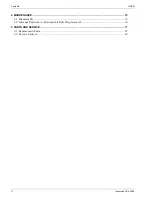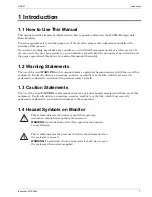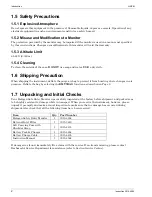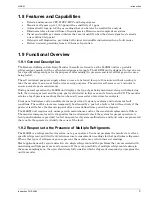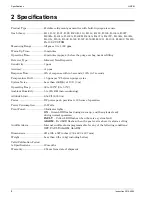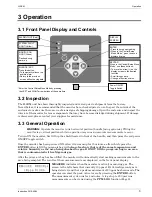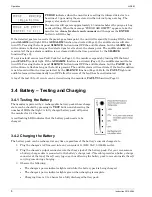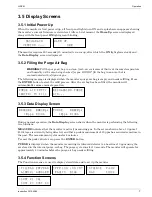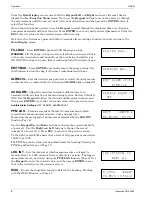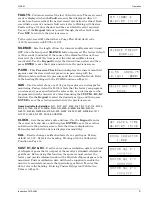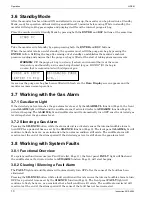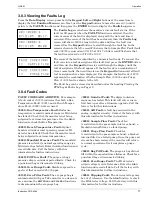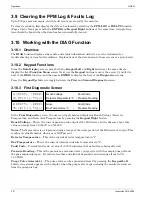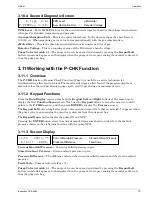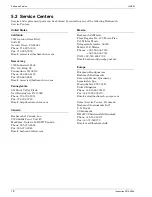
Operation
H-SEM
14
Instruction 3015-4584
R134A CALFACTOR
1.000
CUSTOM CAL K^1
xxxx.xxx
CUSTOM CAL K^2
yyyy.yyy
CUSTOM CAL K^3
zzzz.zzz
3.12 Entering Custom Refrigerant Calibration Values
In addition to the pre-programmed refrigerant gases available for selection,
a custom gas can be added by using the
CUST K1, K2 & K3
function.
Before using this function, the user must contact the factory and provide
information about the gas to be monitored. The factory will then supply
values for K1, K2, and K3, which are the coefficients of a polynomial
equation that represent the calibration curve of the custom gas.
From the
Data Display
screen, press both
the
Keypad
Left
and
Right
buttons at the same time to display the first
Function Menu
screen. Next,
use the
Keypad
buttons to move the arrow (>) until it points to the
CUST
K1
function, and then press
ENTER
to display the
CUSTOM CAL K^1
screen. Use the
Keypad
buttons to enter the 1
st
coefficient value (K1) as received from the factory. Press
ENTER
to store this value. Repeat this procedure to enter the values for K2 and K3.
Select the custom gas for monitoring by using the
GAS
function (Page 9).
3.13 Working with the Calibration Function
If greater than standard accuracy is desired, the factory’s default calibration factor of 1.000 may be
adjusted by performing the calibration procedure as described below, and then selecting the monitor’s
CAL
function to enter the new calibration factor.
IMPORTANT:
Changing the calibration factor will VOID the factory calibration. Typically, the monitor will
remain within the factory-calibrated accuracy indefinitely and no calibration is required. Complex software
algorithms adjust for temperature drift, IR source aging, and pressure changes in order to keep the unit
within factory accuracy specifications.
3.13.1 Calibration Procedure
The calibration factor is determined by sampling a known concentration of R-134A refrigerant gas. A
cylinder of a certified calibration gas must be used to ensure that the gas sample is a known concentration
at ambient conditions. A minimum sample size of 5 liters is required.
Calibration is best performed at or near full scale (1,000 ppm). It can, however, be done at any
concentration and ideally in the range where maximum accuracy is desired down to, but not below,
100 ppm.
The monitor should be operating for at least one hour prior to performing a calibration.
Prepare the monitor for sampling by using the
CAL
function to set the calibration factor to 1.000. Also,
use the
LOG INT
function to set the log interval to 1 minute.
With the monitor operating normally, connect the gas-sample bag directly to the gas-inlet port and allow
the monitor to sample the entire bag. When sampling is complete, view the logged ppm values using the
PPM LOG
function. If the bag was large enough for multiple samples, average the most stable ones. The
new calibration factor is computed by dividing the known gas concentration value by the measured value.
Typically this number will be between 0.95 and 1.05. Use the
CAL
function as described below to enter
the new calculated calibration factor
3.13.2 Adjusting Calibration Factor
From the
Data Display
screen, press both
the
Keypad
Left
and
Right
buttons at the same time to display the first
Function Menu
screen. Next,
use the
Keypad
buttons to move the arrow (>) until it is next to the
CAL
function, and then press
ENTER
to display the
Calibration
screen.
With the
Calibration
screen displayed, use the
Keypad
buttons to enter the new calibration factor. Press
ENTER
to save this value.

